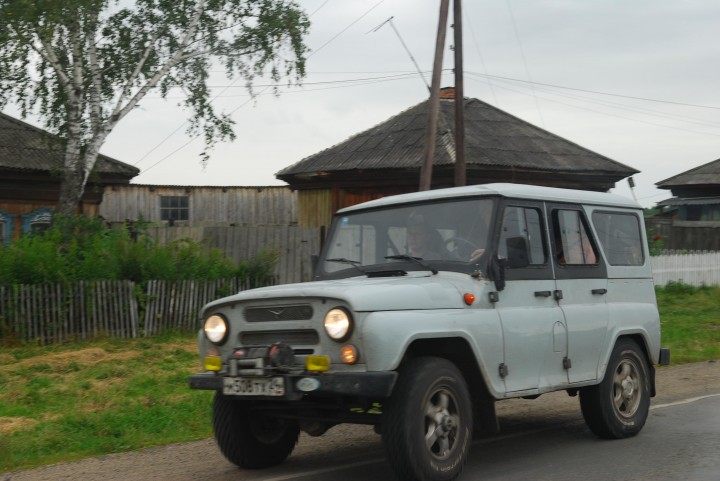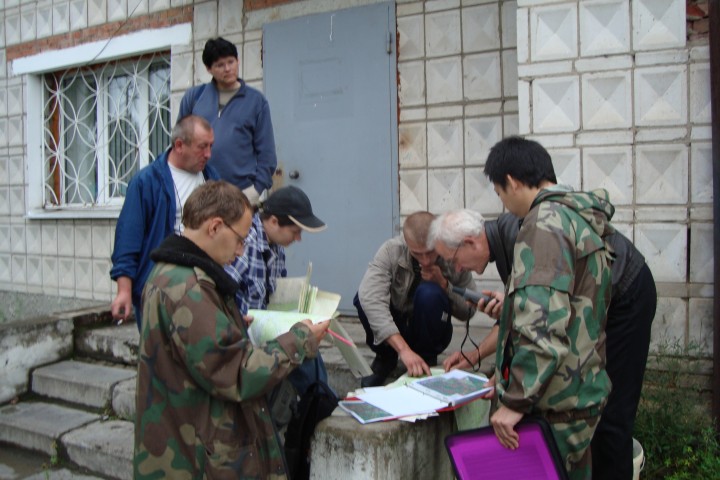Tomsk Oblast 57.22 N 83.53 E
11:22 pm Tomsk local; 12:22 pm, next day, EST
High 70 F Low 49 F Clear skies
Today was a long day of slow progress. At the end of a tiring journey, we are now snug in a wonderful little camp, with a bright half-moon shining over the lake next to our tents. But, unfortunately, Bely Yar still eludes us.
We woke up early this morning, broke camp and loaded up as quickly as possible. By 8:30 the sun was up and we were on our way. After rattling down our rugged forest road for a bit, Slava discovered a leaking tire. Fortunately we soon found the village of Komsomorsk and even more fortunately we found a good mechanic, a nice young man who had grown up in the region.

Like most folks around here, our mechanic was friendly and enjoyed chatting. He told us that his family had been exiled here in the 1930’s, under Stalin’s regime. It turns out that it is quite likely that his family had lived in the very same forest we worked two days ago – the forest where we found the old, sad stumps.
His family had been rounded up in Russia and forced into exile at Shushenskoye, a town built at the confluence of the Yenisei and Big Shush Rivers in the southern part of Krasnoyarsk Krai. It’s a famous town, because it is site of Vladimir Lenin’s exile from 1897 to 1900.
The families were allowed to stay in town for a little while. Then, suddenly, the Russians came and packed them up, along with many others, and transported them to a “special settlement” near the Chulym River. They were dropped in the middle of the wild forest with just a few tools, and told to go to work and build cabins for themselves. This was just before winter set in, he said. That would make it this time of year, probably in August. So we are experiencing what conditions may have been like for those kulaks so long ago. They would have had mild, probably rainy weather for a few weeks longer. And then winter would come.
When winter comes to Siberia, it moves in fast and hard. In this area, average August high temperatures are in the low 70’s. By September, average highs fall to the low 50s and snows may start falling. It gets worse from there – and quickly. Food is reasonably available in the summer, but one can’t start a garden in August – there is no time – so they would have had to live off the land, without a garden and without reserve food. In the winter, food becomes quite scarce. One can hunt, but there is not much vegetation to gather. It was not a very good situation, to say the least. Our friend says that of the 300 people who were put out at that site, only 30 survived the first winter.
Besides these “special settlements”, the Russians also had Gulags in this area. These were forced-labor prison camps. If the kulaks had it bad, those locked away in Gulag had it much worse. Prisoners were supposed to be provided with food, a luxury the kulaks did not enjoy, but at least the kulaks could strive to survive and they held their fate, as bleak as it was, in their own hands. Prisoner’s lives were at the whim of the State and particularly at the whim of the prison guards – most of whom were well-hardened men, if not outright cruel. If kulaks were cold, they could look for kindling and have a chance at a fire. Prisoners might be shot for trying the same thing – or freeze to death if they did not. Suffering from extreme conditions, lack of nourishment and extraordinary work loads, survival rates in Siberian Gulag were very low.
After hearing about these hard times, we felt pretty happy that our troubles were so simple. The tire was repaired and off we drove. To reach Bely Yar tonight, we would have to head west hundreds of kilometers to Tomsk, then turn north and drive hundreds more kilometers in that direction. In the end, we’d be fairly close to where we left last night, but on the other side of the impassible road. What a very long diversion, just because of one bad road! Around here, you can’t just hop off the beltway at the next exit and drive a parallel route, like we do where I’m from. In many areas, here there’s only one route in, and one route out. And when that fails, it’s time for creativity. And patience.
We soon reached Tomsk, where we had planned to shop for supplies and another GPS. Having a second GPS which would let us divide up into two groups and work two plots simultaneously. So we were glad to take a break there. And that’s where we heard the news that Slava’s car was having steering problems. We figured that being able to steer might be a bit important, so he went off to get the car fixed, with our blessing.
It seems we’re having a lot of car trouble on this trip, but then again, this is not an easy trip for any car at all. Some of these roads might even be a challenge for a horse – or a human. Slava drives a UAZ 469, which is a boxy, Russian-made, four wheel drive vehicle. UAZ (pronounce that as “you –oz”, cars have a simple design, so they can be worked on by their owners, because Russians seem to prefer being independent. The cars, especially those built up to 1990, have a reputation for being very reliable and rugged. Our blue Pill is also a UAZ and is also a four wheel drive. I once read that there is a saying in Russia that goes “a UAZ will break down where no other car will go”. I don’t think many other cars would have gotten us into the forest on yesterday’s roads, so I guess we can forgive a bit of trouble.
By the time Slava and his UAZ returned, it was so late we had to give up once again on our quest to reach the fabled Bely Yar, at least temporarily. Slava had asked around and found a promising camp location to our north and west, so off we went to try to find a place to park and sleep for the night. As it was, we rattled up another rough road to the camp just as the sun was getting ready to set.
Whoever turned us on to this spot certainly was kind. It is a nice flat meadow right next to a little lake. I am told that it is in an area called Charevo Shayno, which translates as “Twisted Neck”. I have no idea how it got that name, and I’m not sure I even want to speculate. But I do know this is a beautiful campsite and I feel lucky we get to take a rest here.
As I was putting up my tent, I looked across the lake and the sun was going down. The sky was full of colors and it all looked so very peaceful as the sun slowly set. Then a million stars came out against the blackest sky you can imagine. Tonight the sky is very clear and the half-moon looks very white and bright. We will sleep well at Twisted Neck, I think.
Morning will come quite early. We’ve left everything but the most essential gear in the vehicles, so all we need to do is get up, grab a bite to eat and pack up minimal gear. We need to be on the road by 6:30 in the morning. We have another 4-5 hours driving ahead of us, and we’d like to try to get a little time working the forest tomorrow afternoon. The night is beautiful, but morning will come early, so it’s time to close this entry. Don’t forget to look at the moon tonight, wherever you are.





Cool =)